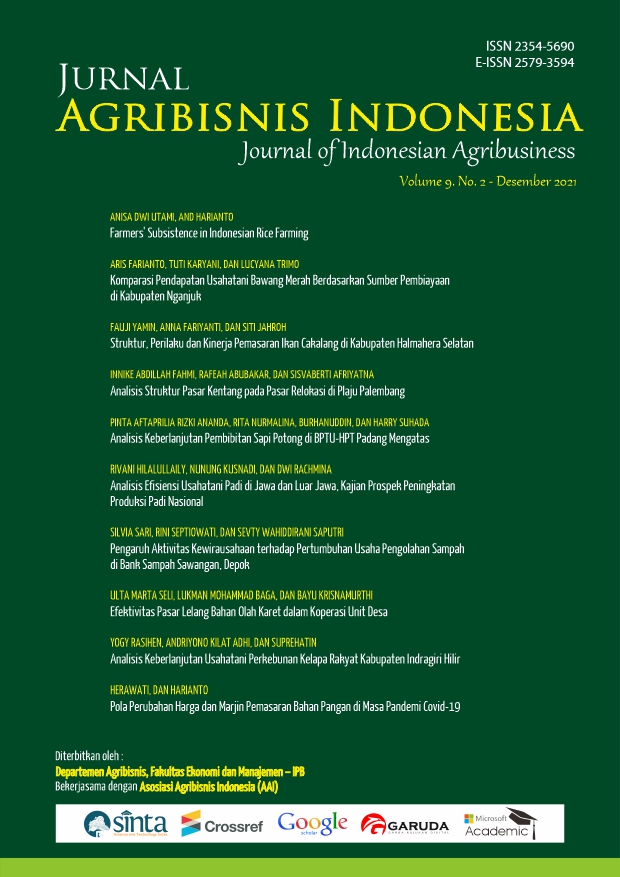Pola Perubahan Harga dan Marjin Pemasaran Bahan Pangan di Masa Pandemi Covid-19
Main Article Content
Abstract
Food products are the main concern for the government and people of Indonesia. Changes in food prices have significant effects on the welfare of the population. Covid-19 pandemic has significantly affected community activities and the food agribusiness system. This study analyzes patterns of changes in prices and marketing margins of seven main food products in Indonesian food consumption i.e. rice, shallots, garlic, red chillies, cayenne pepper, cooking oil, and sugar, after the Covid-19 pandemic by presenting descriptive statistics of daily food prices data from the National Strategic Food Price Information Center (PIHPSN). Based on empirical results, except for shallots and cooking oil, most food prices at various market levels have fallen during the Covid-19 pandemic. On the other hand, the risk of food prices at various levels of the market has been increasing. During the Covid-19 pandemic, the magnitude and variability of marketing margins along the marketing chain also have been increasing. These findings imply the urgency of Institutional policies that can increase market transparency and competition appears to be more effective in the long term at reducing the price shocks caused by Covid-19 at various levels of the market than price interventions.
Downloads
Article Details
Jurnal Agribisnis Indonesia (JAI) is an Open Access Journal. The authors who publish the manuscript in this journal agree to the following terms:
Creative Commons License
JAI is licensed under a Creative Commons Attribution 4.0 International License. This permits anyone to copy, redistribute, remix, transmit, and adapt the work provided the original work and source are appropriately cited.
This means:
(1) Under the CC-BY license, authors retain ownership of the copyright for their article, but authors grant others permission to use the content of publications in Jurnal Agribisnis Indonesia in whole or in part provided that the original work is properly cited. Users (redistributors) of JAI are required to cite the original source, including the author's name, JAI as the initial source of publication, year of publication, volume number, issue, and Digital Object Identifier (DOI); (2) Authors grant JAI the right of first publication. Although authors remain the copyright owner.
References
Huang, J. (2020). Impacts of COVID-19 on agriculture and rural poverty in China. Journal of Integrative Agriculture, 19(12): 2849–2853. https://doi.org/10.1016/S2095-3119(20)63469-4
JICA. 2018. Market study on food sector in Indonesia. Indonesia.
Min, S., Xiang, C., & Zhang, X. H. (2020). Impacts of the COVID-19 pandemic on consumers’ food safety knowledge and behavior in China. Journal of Integrative Agriculture, 19 (12): 2926–2936. https://doi.org/10.1016/S2095-3119(20)63388-3.
Nchanji, E., Lutomia, C. K., Chirwa, R., Templer, N., Rubyogo, J. C., & Onyango, P. (2020). Immediate impacts of COVID-19 pandemic on bean value chain in selected countries in sub-Saharan Africa. Agricultural Systems, 103034. https://doi.org/10.1016/j.agsy.2020.103034.
Nurjanah, R., Purwanto, Y.A. & Sutrisno. (2014). Pengaruh jenis kemasan dan penyimpanan dingin terhadap mutu fisik cabai merah. Jurnal Pascapanen, 11(1):19-29.
Nuryanti, S. (2018). Swasembada Beras Berkelanjutan: Dilema antara Stabilisasi Harga dan Distribusi Pendapatan. Forum Penelitian Agro Ekonomi, 35(1), 19-30. https://dx.doi.org/10.21082/fae.v35n1.2017.19-30%201.
Pahulu, H. F., Davidson, R. T., Dunn, M. L., Ogden, L. V., Steele, F. M., & Pike, O. A. (2007). Change in Mutagenicity in White Rice after Accelerated and Long‐Term Storage. Journal of food science, 72(2), C126-C131. https://doi.org/10.1111/j.1750-3841.2006.00259.x.
Pan, D., Yang, J., Zhou, G., & Kong, F. (2020). The influence of COVID-19 on agricultural economy and emergency mitigation measures in China: A text mining analysis. PloS one, 15(10), e0241167. https://doi.org/10.1371/journal.pone.0241167.
Pangaribowo, E. H. (2014). Consumption Behavior of the Poorest and Policy Implications in Indonesia. In Marginality (pp. 221-237). Springer, Dordrecht. https://doi.org/10.1007/978-94-007-7061-4_14.
Poudel, P. B., Poudel, M. R., Gautam, A., Phuyal, S., Tiwari, C. K., Bashyal, N., & Bashyal, S. (2020). COVID-19 and its Global Impact on Food and Agriculture. Journal of Biology and Today’s World, 9(5), 221.
Rahman, M. E., Sinaga, B. M., & Susilowati, S. H. (2019). Kebijakan Dukungan Domestik untuk Menetralisir Dampak Negatif Penurunan Tarif Impor Terhadap Industri Gula Indonesia. Jurnal Agro Ekonomi, 36(2), 91-112. DOI: http://dx.doi.org/10.21082/jae.v36n2.2018.91-112
Rahmawati, A., Fariyanti, A., & Rifin, A. (2018). Spatial Market Integration of Shallot in Indonesia. Jurnal Manajemen & Agribisnis, 15(3), 258-258. https://doi.org/10.17358/jma.15.3.258.
Sahoo, J.P., & Samal, K. (2020). Impacts of Covid-19 on Indian Agriculture. Agriculture Letters, 1(3):45-46.
Saliem, H. P., Agustian, A., & Perdana, R. P. (2020). Dinamika harga, permintaan, dan upaya pemenuhan pangan pokok pada era pandemi Covid-19. Draft makalah Buku Bunga Rampai Covid-19. Bogor (ID): Pusat Sosial Ekonomi dan Kebijakan Pertanian.
Samira, A., Woldetsadik, K., & Workneh, T. S. (2013). Postharvest quality and shelf life of some hot pepper varieties. Journal of food science and technology, 50(5), 842-855. https://doi.org/10.1007/s13197-011-0405-1.
Sativa, M., Harianto, & Suryana, A. (2017). Impact of red chilli reference price policy in Indonesia. International Journal of Agriculture System, 5(2): 120-139. http://dx.doi.org/10.20956/ijas.v5i2.1201.
Siche, R. (2020). What is the impact of COVID-19 disease on agriculture?. Scientia Agropecuaria, 11(1), 3-6. http://dx.doi.org/10.17268/sci.agropecu.2020.01.00.
Tanger, S. (2020). Economic Impacts of COVID-19 on Food and Agricultural Markets. Technical Report.
Tesfa, T., Woldetsadik, K., & Bayu, W. (2015). Shallot yield, quality and shelf-life as affected by Nitrogen fertilizer. International Journal of Vegetable Science, 21(5):454-466. DOI:10.1080/19315260.2014.895790.
Urumugam, U., Kanagavalli, G., & Manida, M. (2020). Covid-19: Impact of agriculture in India. Aegaeum Journal, 8(5): 480-488. https://ssrn.com/abstract=3600813.
Varshney, D., Roy, D., & Meenakshi, J. V. (2020). Impact of COVID-19 on agricultural markets: assessing the roles of commodity characteristics, disease caseload and market reforms. Indian economic review, 55(1), 83-103. https://doi.org/10.1007/s41775-020-00095-1.
Vatsyayan, S., Brar, P.S., & Dhali, R.K. (2014). Assessment of shelf life of garlic (Allium Sativum L.) ecotypes. Indian Journal of Ecology, 41(2):385-388.
Zhou, J. H., Han, F., Li, K., & Wang, Y. (2020). Vegetable production under COVID-19 pandemic in China: An analysis based on the data of 526 households. Journal of Integrative Agriculture, 19 (12): 2854–2865. DOI: 10.1016/S2095-3119(20)63366-4.

